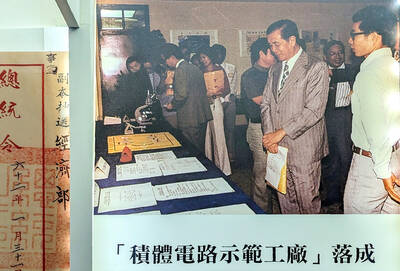Fantome, Ou Es-Tu? (酷馬)
Fantome, Ou Es-Tu?
(酷馬) begins with Cool-ma, a teenage marathon runner, accidentally being killed in a gang fight. His spirit lingers on, though, worried that no one will take care of his widowed mother, and the only person able to see the apparition is Cool-ma’s slayer, Tangguo, a restless tomboy whose rich parents have little time for her. The two become friends, and Tangguo takes Cool-man’s place on the marathon team. With a 30-year career in film and television drama under her belt, female director Wang Shau-di (王小棣) is noted for exploring humanity through melodrama. As in her previous works, emotions take precedence over aesthetics and style in Fantome, Ou Es-Tu? Sean Huang (黃遠), who plays Cool-ma, and Jin Cheng (鄭靚歆), cast as Tangguo, are worth a mention for their debut efforts as actors. But the star of the film is renowned choreographer and dancer Ku Min-shen (古名伸), who gives a powerful and memorable performance as a mother gone mad after losing her only child.
Adventure of the King (龍鳳店)
This action comedy starring Hong Kong mega-star Richie Ren (任賢齊) and Taiwan’s very own Barbie Hsu (徐熙媛), otherwise known as Big S (大S), has been slated by the Chinese-language media as a soulless retread of a topic that has been well covered in cinema, and to add insult to injury, it deploys old jokes and stale comic action. The film draws inspiration from the legends surrounding the fondness of the Ming Dynasty emperor Zhengde (正德皇帝) for life on the streets. In one of these ventures he gets separated from his retinue, conveniently loses his memory, and is helped by a beautiful woman who runs an unsuccessful restaurant. A combination of their talents sees her fortunes turn around, but also brings Zhengde to the attention of those who would rather keep the emperor out of the way for good. Big S puts in a solid performance, but only really enters the story during the second hour, which is too late to save the film. There is speculation that Adventure of the King might aspire to being the worst Chinese film of this year, which is no small achievement.
About Her Brother (Ototo)
A film by director Yoji Yamada, who brought us the Tora-san movies and in later life redefined the samurai movie with such classics as the Fujisawa trilogy. Yamada has proven himself a master of exploring complex historical relationships on a human scale, and has a particularly fine command of Japan’s multifaceted transition from tradition to modernity. His skill with female characters has also been widely praised. About Her Brother focuses on three women from three generations, a wedding ceremony and a younger brother who upsets the apple cart of propriety with his drunkenness and childish pranks, but finds he can always return to the protection of his sister. When the younger brother develops lung cancer and saddles his sister with huge gambling debts, Yamada gets serious with tugging at the heartstrings.
Devil
A film “from the mind of M. Night Shyamalan,” according to the official trailer, may just make you thankful that at least it is not actually directed by the embattled auteur and perpetrator of The Last Airbender. Directed by Drew and John Erick Dowdle, the story has five people trapped in an elevator in one of those super high-tech buildings. But one of the occupants isn’t what he, or she, appears to be. So guess what? Well, the title is a bit of a giveaway, but M. Night Shyamalan can usually be relied upon to insert a heavy load of New Age mystification into the proceedings, and an inexplicable twist at the end.
Ong Bak 3
Muay Thai meets some seriously messed up mythology and the prodigious martial arts and stunt choreography talents of Tony Jaa in this third installment of the Ong Bak saga. Ong Bak 3 is actually the second prequel to the first film Ong-Bak: Muay Thai Warrior released in 2003, which has since garnered a solid cult audience that extends well beyond Thailand. The violence is bloody, the plot is convoluted in the extreme, and an undercurrent of pop Buddhist cosmology and anti-authoritarian sentiment runs through the film, giving it some semblance of depth. Ong Bak 3 picks up from the cliffhanger ending of Ong Bak 2, which might make it difficult to follow if you aren’t up on all the details of the story, but the action is probably worth watching for its own sake (There is some radical stunt work featuring elephants). This installment pits Jaa against fellow martial arts sensation Dan Chupong, who plays a supernatural warrior.
Dancing Dreams
A real treat for lovers of dance, this German documentary takes a look at a recent project by the late Pina Bausch, one of the most influential figures in contemporary dance, who selected 40 students from across Germany, many of whom had never even heard of her, and put them through an intense 10-month rehearsal for the production of Contact Zone (Kontakthof). The dance deals with the search for love and tenderness, and was intended to be a particular challenge for the young dancers participating in the project. The film was a sensation at this year’s Berlin Film Festival and serves as a fitting elegy for Bausch, who died last year.

Oct. 27 to Nov. 2 Over a breakfast of soymilk and fried dough costing less than NT$400, seven officials and engineers agreed on a NT$400 million plan — unaware that it would mark the beginning of Taiwan’s semiconductor empire. It was a cold February morning in 1974. Gathered at the unassuming shop were Economics minister Sun Yun-hsuan (孫運璿), director-general of Transportation and Communications Kao Yu-shu (高玉樹), Industrial Technology Research Institute (ITRI) president Wang Chao-chen (王兆振), Telecommunications Laboratories director Kang Pao-huang (康寶煌), Executive Yuan secretary-general Fei Hua (費驊), director-general of Telecommunications Fang Hsien-chi (方賢齊) and Radio Corporation of America (RCA) Laboratories director Pan
The consensus on the Chinese Nationalist Party (KMT) chair race is that Cheng Li-wun (鄭麗文) ran a populist, ideological back-to-basics campaign and soundly defeated former Taipei mayor Hau Lung-bin (郝龍斌), the candidate backed by the big institutional players. Cheng tapped into a wave of popular enthusiasm within the KMT, while the institutional players’ get-out-the-vote abilities fell flat, suggesting their power has weakened significantly. Yet, a closer look at the race paints a more complicated picture, raising questions about some analysts’ conclusions, including my own. TURNOUT Here is a surprising statistic: Turnout was 130,678, or 39.46 percent of the 331,145 eligible party

The classic warmth of a good old-fashioned izakaya beckons you in, all cozy nooks and dark wood finishes, as tables order a third round and waiters sling tapas-sized bites and assorted — sometimes unidentifiable — skewered meats. But there’s a romantic hush about this Ximending (西門町) hotspot, with cocktails savored, plating elegant and never rushed and daters and diners lit by candlelight and chandelier. Each chair is mismatched and the assorted tables appear to be the fanciest picks from a nearby flea market. A naked sewing mannequin stands in a dimly lit corner, adorned with antique mirrors and draped foliage

The election of Cheng Li-wun (鄭麗文) as chair of the Chinese Nationalist Party (KMT) marked a triumphant return of pride in the “Chinese” in the party name. Cheng wants Taiwanese to be proud to call themselves Chinese again. The unambiguous winner was a return to the KMT ideology that formed in the early 2000s under then chairman Lien Chan (連戰) and president Ma Ying-jeou (馬英九) put into practice as far as he could, until ultimately thwarted by hundreds of thousands of protestors thronging the streets in what became known as the Sunflower movement in 2014. Cheng is an unambiguous Chinese ethnonationalist,